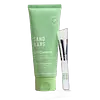What's inside
What's inside
 Key Ingredients
Key Ingredients

 Benefits
Benefits

 Concerns
Concerns

 Ingredients Side-by-side
Ingredients Side-by-side

Water
Skin ConditioningKaolin
AbrasiveBentonite
AbsorbentCannabis Sativa Seed Oil
EmollientAloe Barbadensis Leaf
MaskingHamamelis Virginiana Extract
AntiseborrhoeicHyaluronic Acid
HumectantCamellia Sinensis Callus
AntimicrobialLycium Chinense Fruit Extract
AntioxidantVanilla Planifolia Fruit Extract
Skin ConditioningPersea Gratissima Oil
Skin ConditioningPrunus Amygdalus Dulcis Oil
Skin ConditioningAscorbic Acid
AntioxidantGlycerin
HumectantTocopheryl Acetate
AntioxidantPhenoxyethanol
PreservativeEthylhexylglycerin
Skin ConditioningCI 77288
Cosmetic ColorantWater, Kaolin, Bentonite, Cannabis Sativa Seed Oil, Aloe Barbadensis Leaf, Hamamelis Virginiana Extract, Hyaluronic Acid, Camellia Sinensis Callus, Lycium Chinense Fruit Extract, Vanilla Planifolia Fruit Extract, Persea Gratissima Oil, Prunus Amygdalus Dulcis Oil, Ascorbic Acid, Glycerin, Tocopheryl Acetate, Phenoxyethanol, Ethylhexylglycerin, CI 77288
Water
Skin ConditioningKaolin
AbrasiveMagnesium Aluminum Silicate
AbsorbentGlycerin
HumectantPropanediol
SolventButylene Glycol
HumectantFomes Officinalis Extract
Skin ProtectingMicrocrystalline Cellulose
AbsorbentSalicylic Acid
MaskingPhenoxyethanol
PreservativePolyacrylate Crosspolymer-6
Emulsion StabilisingDecyl Glucoside
CleansingNiacinamide
SmoothingAloe Barbadensis Leaf Juice
Skin ConditioningSodium Hydroxide
BufferingCellulose Gum
Emulsion StabilisingCI 77288
Cosmetic ColorantMaltodextrin
AbsorbentBixa Orellana Seed Extract
MaskingEthylhexylglycerin
Skin ConditioningTetrasodium Glutamate Diacetate
Citric Acid
BufferingInulin
Skin ConditioningZinc Oxide
Cosmetic ColorantTasmannia Lanceolata Fruit/Leaf Extract
AntioxidantCentipeda Cunninghamii Extract
Skin ConditioningCitrus Australasica Fruit Extract
AntioxidantAlpha-Glucan Oligosaccharide
CleansingSalix Alba Bark Extract
AstringentPEG-40 Hydrogenated Castor Oil
EmulsifyingHamamelis Virginiana Leaf Extract
Skin ConditioningSodium Benzoate
MaskingPotassium Sorbate
PreservativeWater, Kaolin, Magnesium Aluminum Silicate, Glycerin, Propanediol, Butylene Glycol, Fomes Officinalis Extract, Microcrystalline Cellulose, Salicylic Acid, Phenoxyethanol, Polyacrylate Crosspolymer-6, Decyl Glucoside, Niacinamide, Aloe Barbadensis Leaf Juice, Sodium Hydroxide, Cellulose Gum, CI 77288, Maltodextrin, Bixa Orellana Seed Extract, Ethylhexylglycerin, Tetrasodium Glutamate Diacetate, Citric Acid, Inulin, Zinc Oxide, Tasmannia Lanceolata Fruit/Leaf Extract, Centipeda Cunninghamii Extract, Citrus Australasica Fruit Extract, Alpha-Glucan Oligosaccharide, Salix Alba Bark Extract, PEG-40 Hydrogenated Castor Oil, Hamamelis Virginiana Leaf Extract, Sodium Benzoate, Potassium Sorbate
 Reviews
Reviews

Ingredients Explained
These ingredients are found in both products.
Ingredients higher up in an ingredient list are typically present in a larger amount.
Ci 77288 is used to add green pigment to products.
Ethylhexylglycerin (we can't pronounce this either) is commonly used as a preservative and skin softener. It is derived from glyceryl.
You might see Ethylhexylglycerin often paired with other preservatives such as phenoxyethanol. Ethylhexylglycerin has been found to increase the effectiveness of these other preservatives.
Glycerin is already naturally found in your skin. It helps moisturize and protect your skin.
A study from 2016 found glycerin to be more effective as a humectant than AHAs and hyaluronic acid.
As a humectant, it helps the skin stay hydrated by pulling moisture to your skin. The low molecular weight of glycerin allows it to pull moisture into the deeper layers of your skin.
Hydrated skin improves your skin barrier; Your skin barrier helps protect against irritants and bacteria.
Glycerin has also been found to have antimicrobial and antiviral properties. Due to these properties, glycerin is often used in wound and burn treatments.
In cosmetics, glycerin is usually derived from plants such as soybean or palm. However, it can also be sourced from animals, such as tallow or animal fat.
This ingredient is organic, colorless, odorless, and non-toxic.
Glycerin is the name for this ingredient in American English. British English uses Glycerol/Glycerine.
Learn more about GlycerinKaolin is a clay. It is used for oil control and to help minimize pores. Like other clays, kaolin has the ability to absorb excess sebum or oil. This can help clean out pores and mattify the skin.
Some types of kaolin may have exfoliating properties. When water is added to kaolin, it becomes a paste with small abrasive particles.
Most kaolin is a white color, but may be pink/orange/red depending on where it comes from.
The name 'kaolin' comes from a Chinese village named 'Gaoling'. Kaolin clay comes from rocks rich in kaolinite. Kaolinite, the mineral, has a silicate layered structure. Kaolinite is formed from chemical weathering of aluminum siilicate minerals.
Besides skincare, kaolin is commonly used to make glossy paper, in ceramics, toothpaste, and as medicine to soothe stomach issues.
Learn more about KaolinPhenoxyethanol is a preservative that has germicide, antimicrobial, and aromatic properties. Studies show that phenoxyethanol can prevent microbial growth. By itself, it has a scent that is similar to that of a rose.
It's often used in formulations along with Caprylyl Glycol to preserve the shelf life of products.
Water. It's the most common cosmetic ingredient of all. You'll usually see it at the top of ingredient lists, meaning that it makes up the largest part of the product.
So why is it so popular? Water most often acts as a solvent - this means that it helps dissolve other ingredients into the formulation.
You'll also recognize water as that liquid we all need to stay alive. If you see this, drink a glass of water. Stay hydrated!
Learn more about Water